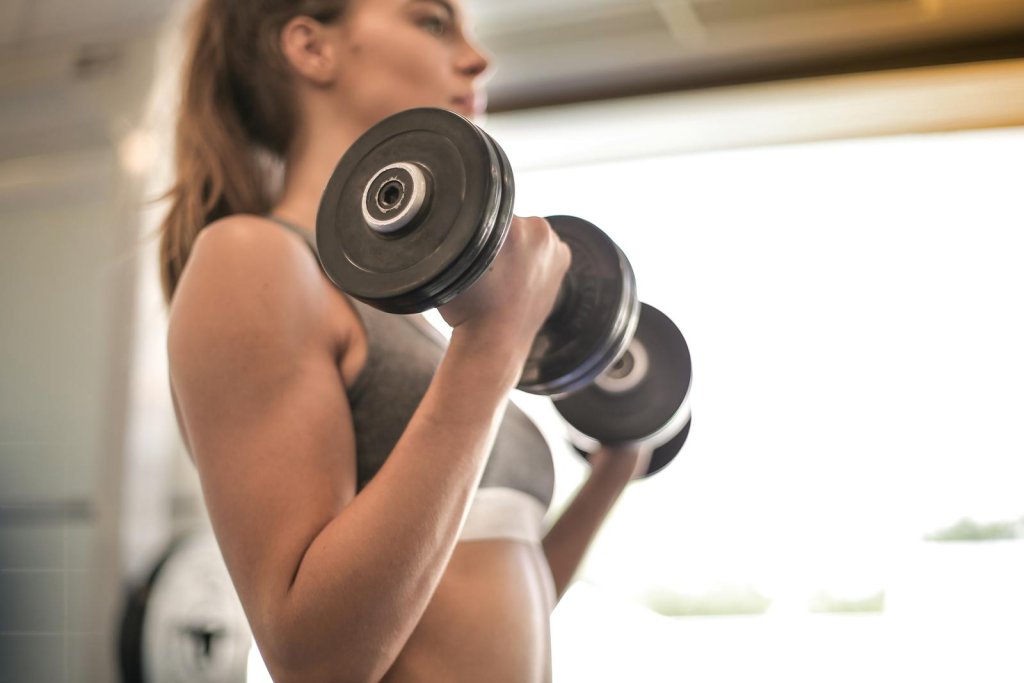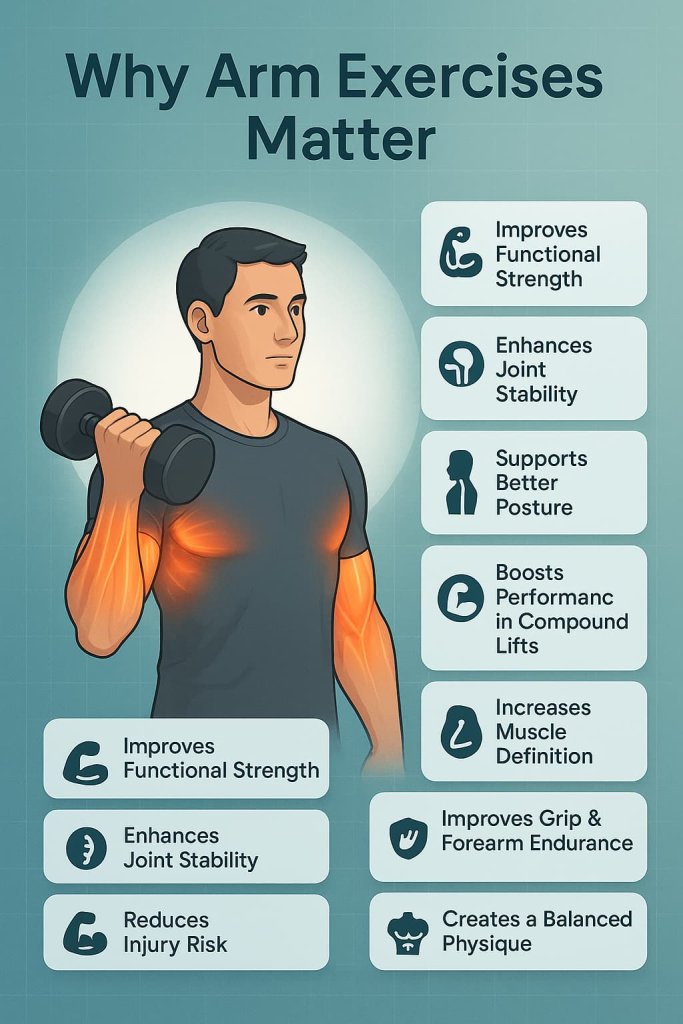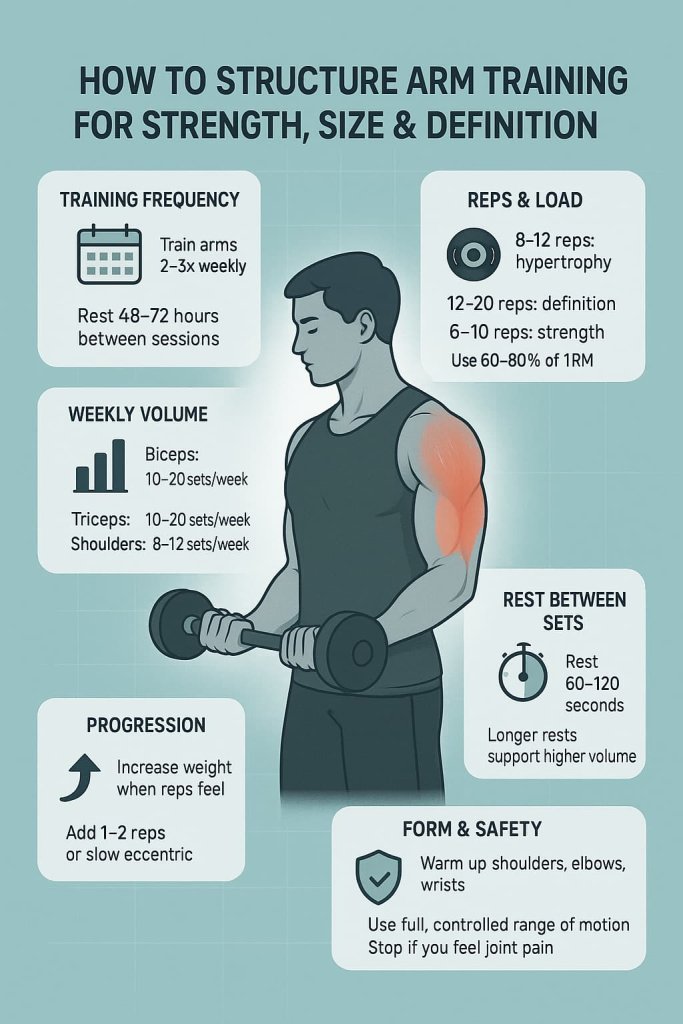The best arm exercises are movements that directly target your biceps, triceps, shoulders, and forearms using a mix of compound and isolation training. These exercises help you build strength, size, and definition by training the main arm muscles through different angles, loads, and resistance patterns.

Understanding how to train arms properly is essential for balanced upper-body development, better pushing and pulling strength, and improved performance in daily tasks and sports. With the right structure—frequency, sets, reps, and technique—you can safely build bigger, stronger arms whether you train at home or in the gym.
This guide includes evidence-based programming, up-to-date recommendations, and 20 of the most effective arm exercises backed by real strength-training research.
Why Arm Exercises Matter
Arm exercises are essential for building a strong, functional upper body and supporting the movements you rely on every day. Training the biceps, triceps, shoulders, and forearms improves strength, control, and joint stability while enhancing overall performance in both workouts and daily life.
Here’s why arm training truly matters:
- Improves daily functional strength: Makes lifting, carrying, pushing, and pulling easier and safer.
- Supports joint stability: Strong triceps and forearms help stabilize the shoulders, elbows, and wrists during all upper-body movements.

- Enhances posture: Strengthening the upper arms and shoulders reduces slouching and supports upright positioning.
- Boosts performance in compound lifts: Exercises like bench press, rows, chin-ups, and overhead press all depend on arm strength.
- Increases muscle definition: Targeted arm work shapes the biceps and triceps for a more sculpted, athletic appearance.
- Improves grip and forearm endurance: Essential for holding weights securely and performing daily tasks.
- Reduces injury risk: Stronger supporting muscles help protect joints and connective tissues during training.
- Balances upper-body physique: Helps create proportionate muscle development across the chest, back, shoulders, and arms.
Consistent arm training not only builds strength and muscle size—it directly improves your ability to move confidently and safely in everyday life.
How to Structure Arm Training for Strength, Size & Definition
Use these research-supported guidelines to build effective arm workouts:

Training Frequency
- Train arms 2–3 days per week.
- Allow 48–72 hours between heavy arm sessions for recovery.
Weekly Volume
- Biceps: 10–20 sets per week
- Triceps: 10–20 sets per week
- Shoulders (for arm appearance): 8–12 sets per week
(ACSM & NSCA recommendations support 2–4 sets per exercise, 8–12 reps for strength and hypertrophy.)
Reps & Load
- 8–12 reps for hypertrophy
- 12–20 reps for definition and metabolic stress
- 6–10 reps for compound strength builders
Moderate to heavy loads (60–80% 1RM) are shown to maximize growth in most adults.
Rest Between Sets
- Studies show resting ≥60 seconds increases training volume and improves hypertrophy.
- Use 60–120 seconds rest for most arm exercises.
Progression
- Add weight once you hit the top of your rep range easily.
- Add 1–2 reps or slow the eccentric phase for added difficulty.
Form & Safety
- Warm up your shoulders, elbows, and wrists.
- Use full range of motion.
- Control the lowering phase.
- Stop if you feel joint pain.
20 Best Arm Exercises to Build Strength, Size & Definition
Arm exercises strengthen the biceps, triceps, and forearms while improving overall upper-body performance. This list highlights the 20 most effective movements to build strength, increase muscle size, and create well-defined arms for any fitness level.
Best Biceps Exercises
1. Barbell Curl
A classic mass builder that allows heavier loading and recruits both heads of the biceps.
Why it works:
The barbell curl enables you to use a stable, bilateral grip, allowing higher loads than most curl variations. This increases mechanical tension—one of the strongest drivers of muscle growth.
Muscles worked:
Biceps brachii (long & short head), brachialis, forearms.
How to do it:
- Stand tall with feet shoulder-width apart and core braced.
- Hold a barbell with an underhand grip, hands shoulder-width apart.
- Curl the bar upward while keeping elbows tucked.
- Squeeze at the top, then lower slowly under control.
Trainer Tip:
Avoid leaning back—keep ribs down and elbows fixed to maximize biceps activation.
2. Dumbbell Alternating Curl
Allows independent arm training and reduces side-dominance issues.
Why it works:
Training one arm at a time improves balance between sides and increases focus on the working biceps.
Muscles worked:
Biceps brachii, brachialis, brachioradialis.
How to do it:
- Stand tall holding dumbbells at your sides.
- Curl one dumbbell up with palms facing forward.
- Lower it fully before switching to the opposite arm.
Trainer Tip:
Rotate your wrist slightly outward at the top to increase peak biceps contraction.
3. Incline Dumbbell Curl
Places the biceps in a stretched position, shown to enhance hypertrophy.
Why it works:
The incline angle stretches the biceps under load, which research shows may amplify muscle-growth signals.
Muscles worked:
Biceps brachii, brachialis.
How to do it:
- Sit on an incline bench set to 45–60 degrees.
- Let your arms hang straight down.
- Curl both dumbbells up without swinging.
- Lower slowly, maintaining the stretch at the bottom.
Trainer Tip:
Keep elbows pointing straight down—don’t let them drift forward or you’ll lose tension.
4. Hammer Curl
Targets the brachialis + brachioradialis for thicker upper arms.
Why it works:
The neutral grip emphasizes the brachialis—a deep muscle that pushes the biceps upward, making arms look larger.
Muscles worked:
Brachialis, brachioradialis, biceps brachii.
How to do it:
- Hold dumbbells with palms facing each other.
- Curl while maintaining the neutral grip.
- Control the lowering phase.
Trainer Tip:
Keep your shoulders from rolling forward—this keeps the load on the elbow flexors, not the traps.
5. Cable Curl (Straight Bar or Rope)
Provides constant tension, ideal for definition.
Why it works:
Cables maintain tension through the entire rep, making them excellent for shaping work and high-rep sets.
Muscles worked:
Biceps brachii, brachialis, forearms.
How to do it:
- Stand close to a low cable machine.
- Grip the bar or rope and curl upward.
- Keep elbows pinned to your sides.
- Lower slowly while resisting cable pull.
Trainer Tip:
Lean slightly forward to prevent your torso from swinging.
6. Preacher Curl (EZ-Bar or Dumbbell)
Reduces momentum and isolates the biceps for strict form.
Why it works:
The preacher pad eliminates cheating by preventing shoulder involvement, forcing the biceps to do all the work.
Muscles worked:
Biceps brachii, brachialis.
How to do it:
- Sit on a preacher bench with arms fully extended on the pad.
- Curl the weight up in a controlled motion.
- Pause briefly at the top, then lower slowly.
Trainer Tip:
Use an EZ-bar to reduce wrist strain and improve comfort.
7. Concentration Curl
Excellent for peak contraction and mind–muscle connection.
Why it works:
This unilateral curl encourages strict form and maximum squeezing of the biceps.
Muscles worked:
Biceps brachii.
How to do it:
- Sit on a bench with knees apart.
- Brace your elbow against your inner thigh.
- Curl the dumbbell up while keeping your torso still.
- Lower with full control.
Trainer Tip:
Focus on slow negatives to intensify the biceps pump.
Best Triceps Exercises
8. Close-Grip Bench Press
A powerful compound lift targeting the triceps while keeping chest involvement moderate.
Why it works:
The narrow grip shifts more load to the triceps, letting you use heavier weight for serious strength and size gains.
Muscles worked:
Triceps brachii, chest, anterior shoulders.
How to do it:
- Lie on a bench and grip the bar slightly inside shoulder width.
- Lower to the lower chest with elbows tucked.
- Press upward in a straight path.
Trainer Tip:
Use a controlled descent to avoid elbow flare and shoulder strain.
9. Parallel Bar Dips
Builds strength and mass in triceps, chest, and shoulders.
Why it works:
Dips train the triceps in a deep range of motion while engaging stabilizing muscles.
Muscles worked:
Triceps, chest, front delts, core.
How to do it:
- Grasp dip bars and support your body.
- Keep torso upright for more triceps activation.
- Lower until elbows reach 90 degrees.
- Push back up to full lockout.
Trainer Tip:
Keep elbows close to your torso to maximize triceps emphasis.
10. Cable Triceps Pushdown (Rope or Bar)
Joint-friendly, high-rep movement for definition and burn.
Why it works:
Cables allow continuous tension and a smooth resistance curve, perfect for isolating the triceps.
Muscles worked:
Triceps brachii (all heads), forearms.
How to do it:
- Stand facing a high cable pulley.
- Grip the rope or bar and tuck elbows in.
- Push down until arms fully extend.
- Control the return.
Trainer Tip:
Separate the rope ends at the bottom for a stronger triceps contraction.
11. Overhead Triceps Extension (DB or Cable)
Lengthens the long head of the triceps for maximum stretch.
Why it works:
The overhead angle stretches the long head—a key driver of arm mass.
Muscles worked:
Triceps (long head emphasis).
How to do it:
- Hold a dumbbell or cable overhead.
- Bend elbows to lower the weight behind your head.
- Extend upward without arching your back.
Trainer Tip:
Keep ribs down and core braced to protect your lower back.
12. Skull Crushers / Lying Triceps Extensions
Highly effective at isolating the triceps long head.
Why it works:
The lying position provides strict elbow flexion/extension, minimizing shoulder involvement.
Muscles worked:
Triceps (all three heads).
How to do it:
- Lie on a bench with EZ-bar or dumbbells.
- Lower the weight toward your forehead or behind head.
- Extend elbows fully without locking harshly.
Trainer Tip:
Lower behind your head to increase long-head stretch and reduce joint stress.
13. Triceps Kickback
Best performed with lighter dumbbells for high-rep shaping work.
Why it works:
Kickbacks target the triceps at peak contraction, ideal for definition.
Muscles worked:
Triceps (lateral head activation is strong).
How to do it:
- Hinge forward with dumbbells in hand.
- Keep elbows high and extend arms straight back.
- Pause briefly at full extension.
Trainer Tip:
Use strict control—swinging reduces triceps tension.
14. Close-Grip Push-Up
Excellent home-workout variation that emphasizes triceps.
Why it works:
Narrow hand placement shifts more load from the chest to the triceps.
Muscles worked:
Triceps, chest, shoulders, core.
How to do it:
- Assume a push-up position with hands close together.
- Lower your chest toward your hands.
- Press upward without flaring elbows.
Trainer Tip:
If too difficult, perform on knees or incline for modification.
Best Forearm & Grip Exercises
15. Reverse Curl (Barbell or EZ-Bar)
Targets the brachioradialis and forearm extensors.
Why it works:
The overhand grip forces more work from the forearm extensors, often neglected in standard curls.
Muscles worked:
Brachioradialis, wrist extensors, biceps (secondary).
How to do it:
- Hold barbell with overhand grip.
- Curl upward without letting wrists bend.
- Lower slowly.
Trainer Tip:
Use an EZ-bar for comfort during longer sets.
16. Wrist Curls (Palms Up & Palms Down)
Isolates wrist flexors and extensors for balanced forearm strength.
Why it works:
Directly targets the small forearm muscles responsible for grip and wrist stability.
Muscles worked:
Wrist flexors, wrist extensors, brachioradialis.
How to do it:
- Sit and rest forearms on thighs.
- Curl your wrists upward (palms up), then repeat palms down.
- Use slow, controlled motion.
Trainer Tip:
Do higher reps (15–20) for best forearm endurance.
17. Farmer’s Carry
Builds tremendous grip strength and forearm endurance.
Why it works:
Carrying heavy weights forces continuous grip engagement and activates stabilizers throughout the upper body.
Muscles worked:
Forearms, grip muscles, traps, core.
How to do it:
- Hold heavy dumbbells at your sides.
- Walk in a straight line with tall posture.
- Keep shoulders pulled back.
Trainer Tip:
Shorter, heavier carries increase forearm activation.
18. Dead Hang (Pull-Up Bar Hold)
Simple and effective for grip, forearms, and shoulder stability.
Why it works:
Hanging from a bar builds isometric grip strength and decompresses shoulders.
Muscles worked:
Forearms, grip muscles, shoulders, lats (stabilizing).
How to do it:
- Grab a pull-up bar with full grip.
- Hang with arms extended and core tight.
- Hold as long as possible.
Trainer Tip:
Use a mixed grip or straps only if necessary for advanced sets.
Compound Movements That Build Bigger Arms
19. Chin-Up
Strongly activates the biceps and upper back, excellent for strength and size.
Why it works:
The underhand grip increases elbow flexion demands, heavily involving the biceps.
Muscles worked:
Biceps, lats, forearms, middle back, core.
How to do it:
- Grab the bar with palms facing you.
- Pull your chin above the bar.
- Lower under full control.
Trainer Tip:
Pause briefly at the top to increase biceps recruitment.
20. One-Arm Dumbbell Row
Trains lats, upper back, and biceps through a long range of motion.
Why it works:
Rowing activates the biceps as a secondary mover while strengthening major back muscles.
Muscles worked:
Biceps, lats, rhomboids, rear delts, core.
How to do it:
- Place one knee on a bench and hinge forward.
- Pull the dumbbell toward your hip.
- Lower slowly with full arm extension.
Trainer Tip:
Think “drive elbow back” rather than “lift the weight” to maximize pulling efficiency.
How to Warm Up Before Arm Workouts
(Use this in every arm-training article for YMYL and safety compliance.)
3–5 Minute Warm-Up
- Arm circles – 20 seconds
- Wall push-ups – 8–10 reps
- Shoulder rolls – 10 each direction
- Band pull-aparts – 12–15 reps
- Wrist mobility circles – 15 seconds each way
Sample Arm Workout (Beginner, Intermediate, Advanced)
Beginner
- Dumbbell Curl – 3×10–12
- Rope Pushdown – 3×12–15
- Hammer Curl – 2×12
- Triceps Kickback – 2×15
Intermediate
- Barbell Curl – 4×8–10
- Close-Grip Bench Press – 4×6–10
- Incline Dumbbell Curl – 3×10–12
- Overhead Triceps Extension – 3×12–15
Advanced
- Weighted Chin-Up – 4×6–8
- Skull Crushers – 4×8–10
- Preacher Curl – 4×10–12
- Dips – 3×8–10
- Cable Curl Finisher – 2×15–20
Safety Tips Before You Begin
Follow these guidelines to protect your joints and train safely:
- Warm up your shoulders, elbows, and wrists with light mobility and activation work.
- Start with lighter weights to learn proper form before increasing load.
- Use slow, controlled movements and avoid swinging or using momentum.
- Keep wrists, elbows, and shoulders aligned throughout each rep.
- Stop immediately if you feel sharp or radiating pain—discomfort in joints is a warning sign.
- Modify exercises if you have a history of shoulder or elbow issues, choosing variations that feel comfortable.
- Progress gradually by increasing weight, reps, or sets only when you can perform each exercise with good technique.
FAQ
1. How many times a week should I train arms?
Two to three sessions per week is ideal for strength and hypertrophy.
2. How many sets should I do for biceps and triceps?
Aim for 10–20 total weekly sets per muscle group.
3. Should I train arms on the same day as chest or back?
Yes—pairing chest with triceps or back with biceps is effective and common.
4. Are cables or free weights better for arms?
Both work. Free weights build strength; cables improve constant tension and definition.
5. How long before I see results?
Most people notice visible changes within 4–8 weeks with consistent training.
6. Do I need heavy weights to build big arms?
Not always—studies show you can build muscle with moderate or light loads if you train close to fatigue.
7. Are arm workouts safe for beginners?
Yes, as long as you use proper form, warm up, and progress gradually.
Conclusion
Building strong, defined arms requires a combination of proven exercises, proper technique, and a structured training plan. By combining compound movements with isolation work—and following evidence-based guidelines—you can grow your biceps, triceps, and forearms safely and effectively.
Start with 2–3 sessions per week, focus on progression, and choose 6–8 exercises from this list to create a balanced routine.
References
- American College of Sports Medicine (2009). “Progression Models in Resistance Training for Healthy Adults.” Medicine & Science in Sports & Exercise.
https://pubmed.ncbi.nlm.nih.gov/19204579/ - **Schoenfeld, B.J. et al. (2021). “Loading Recommendations for Muscle Strength and Hypertrophy.” Sports (Basel). **
https://www.ncbi.nlm.nih.gov/pmc/articles/PMC7927075/ - Baz-Valle, E. et al. (2022). “A Systematic Review of the Effects of Different Resistance Training Volumes on Muscle Hypertrophy.” Sports Medicine – Open.
https://www.ncbi.nlm.nih.gov/pmc/articles/PMC8884877/ - Currier, B.S. et al. (2023). “How Many Times per Week Should a Muscle Be Trained to Maximize Hypertrophy? A Systematic Review and Meta-Analysis.” British Journal of Sports Medicine.
https://bjsm.bmj.com/content/57/18/1211 - Singer, A. et al. (2024). “Give It a Rest: A Systematic Review with Bayesian Meta-Analysis of Rest Interval Duration and Hypertrophy.” Sports Medicine – Open.
https://www.ncbi.nlm.nih.gov/pmc/articles/PMC11349676/ - Kassiano, W. et al. (2023). “Which ROMs Lead to Rome? A Systematic Review of the Effects of Full vs Partial Range of Motion on Muscle Hypertrophy.” Journal of Strength and Conditioning Research.
https://pubmed.ncbi.nlm.nih.gov/36662126/ - Maeo, S. et al. (2023). “Triceps Brachii Hypertrophy Is Substantially Greater After Elbow Extension Training in the Overhead vs Neutral Arm Position.” European Journal of Sport Science.
https://www.tandfonline.com/doi/full/10.1080/17461391.2022.2100279 - da Silva Vendruscolo, L. et al. (2024/2025). “Comparison Between Preacher and Incline Biceps Curls on Elbow Flexor Muscle Size and Strength.” International Journal of Sports Medicine.
https://www.thieme-connect.com/products/ejournals/html/10.1055/a-2517-0509
